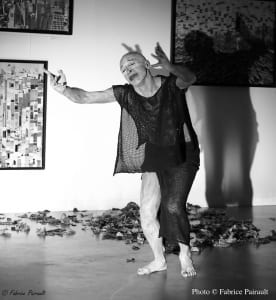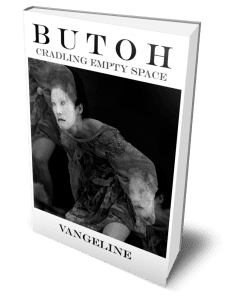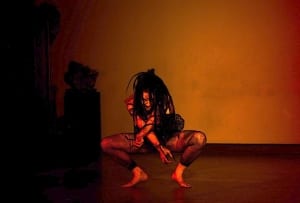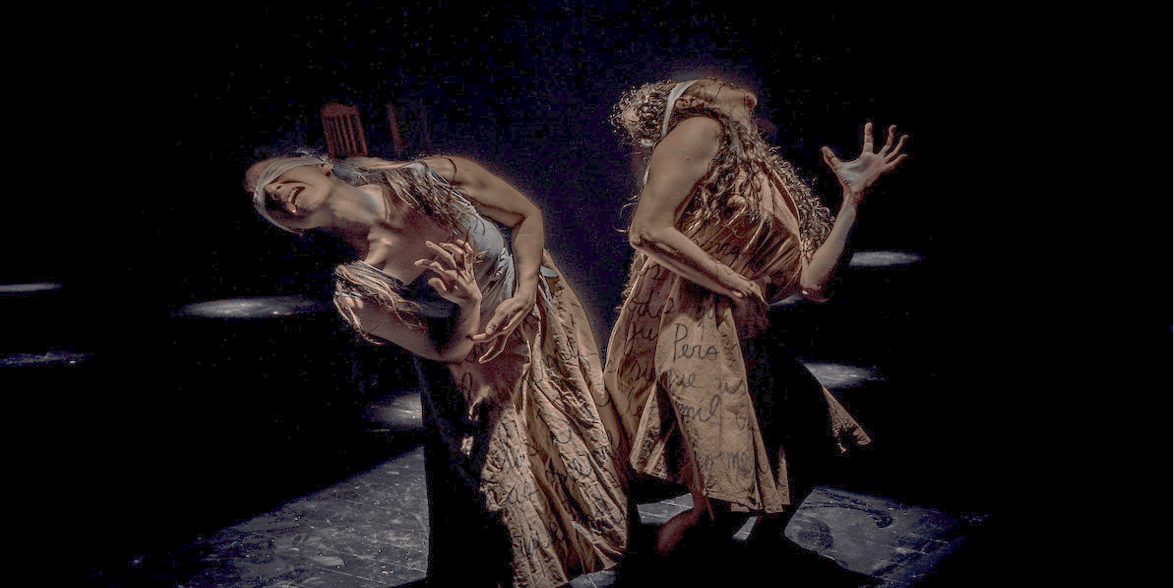Most Americans that think of Butoh imagine it as a Japanese avant-garde dance performed by bald, chiseled men, naked except for a loincloth and a full-body covering of white paint. They might also associate it with images of blood and violence, the aftermath of World War II, or know it as its popular moniker, “The Dance of Darkness.” This, according to Vangeline, the founder of the New York Butoh Institute, author of the newly-published book on Butoh: Cradling Empty Space, and organizer of the New York Butoh Institute Festival 2020, comprises only a small fraction of Butoh. In reality, Butoh is far more varied, and far more difficult to define. The central goal of this year’s festival and Vangeline’s book is to examine the different forms that contemporary Butoh takes, looking at the under-discussed female artists, at the subtler forms of dance that rely more on small movements than on horror aesthetics/the grotesque, and at Butoh as it is practiced in international contexts.

It’s a tricky task and one that Vangeline accomplishes expertly. For much of its existence, Butoh masters and practitioners avoided a formalized definition of their form. The result has been a fluid art form, one that is everything and nothing, that has few rules or clear external markers. It might better be defined as a concept, a practice, a slow-burn internal devotion, something that occasionally borders on the spiritual. In some ways, it’s akin to a séance. The artist channels the body memory of every Butoh practitioner before them, they enter directly into the conversation and make it visible to the audience. Or not. It might be something that attempts to trace the fleeting, moment to moment internal emotional arcs that the performer experiences. Or not. It could be an empty vessel, a body stripped of anything else. Or not. It might be any combination of these things or something else entirely. For all its ambiguity, according to Vangeline a core, unifying concern of Butoh is to make the invisible visible.
Despite the challenge and limitations of adapting such a visceral form for Zoom, the festival proved successful. That said, it’s no real surprise that the standout show, Broken Bodies by the Chilean group Ruta De La Memoria, was the one that relied least on the filigree connections between dancer and audience (which provide the true magic of live theater and die in the webcam) and more on a clear narrative. This piece (directed by Ruta founder Natalia Cuéllar) of interpretative dance-theater memorializes three pregnant women captured, tortured, abused sexually, and ultimately disposed of in the Pacific by Pinochet’s secret police.
At the start, three small pockets of red light envelop three women, balanced on their tailbones. We hear, muffled, like listening through water, two percussive beats, in rapid succession: heartbeats. Stillness, silence. The beats again. The sound of coursing liquid. The women bloom from their curled positions, arms and legs unfurling out, in slow motion. Still suspended on their tailbones, they eventually rest again, splayed, limbs stretching to the four corners, fingers clawed, faces impenetrable. We are in the womb. The performers are the fetuses, the unborn that the dissidents carried with them to their graves. But they are also the women, the women whose bodies we are within. This moment, spread-eagled, is the great violence that starts each life: birth. It’s the moment of ecstasy, of conception. It’s pain, it’s the assault of the officers, all rolled into one gesture.
At the end of this sequence, the women stand, rip from their mouths great fistfuls of rose petals, and scatter them to the floor. What follows is a series of dances that loosely represent a pursuit, capture, interrogation, torture. Then, the rapid percussion of helicopter blades ruptures the silence. On the screen in the background, in grainy, high-contrast film, a uniformed man pilots a chopper over the Pacific, roiled by a slight chop. A splash, a blue wash across the stage, the sound of water pressing on eardrums: our three women are suspended once more, now upright, topless, corkscrewing, pirouetting.
We see no waves, know no current, but feel how both ferry our heroines to martyrdom. The piece opens on the protagonists in an amniotic sack, and ends with them in the great primal amniotic sack which we all crawled from and which we are all doomed to return: the ocean.
Not every show was this mimetic. The festival opened with a series of six shorts films. An intelligent beginning as the films were a microcosm of sorts of the world of Butoh. We saw the grotesque elements in Kori Koolman’s “Living Room,” a piece that opens with two fat-suited figures, one man, one woman, both portrayed by Koolman. An armchair swallows the man, who wears a bushy black wig, an unbuttoned flannel over a t-shirt, and oversized pants. The woman perches on a simple wooden chair, naked, large cartoonish breasts curving outwards from her sternum like eyes looking in opposite directions. A void opens around them on all sides, everything black except for the characters. The piece begins subtly—the characters confined to their chairs, while a soundscape, apparently fashioned from running water and hydraulic machinery, plays. The woman slowly rocks back and forth in her chair. The man collapses himself—almost like a tin can—down into his seat, until his considerable girth nearly disappears. Both keep time with what sounds like the exhalations of a large machine at work. Eventually, they open their mouths in unison, screaming a metallic scream.
The chairs disappear—man and woman stand, facing front. The man pushes his pants down to his ankles and lets the tip of his prosthetic member lap at his knees. A distorted, slower and tinnier version of Mozart’s Requiem plays. The man masturbates, viciously, desperately. The couple shares their climax with the music: the Requiem crescendos, leaps from minor to major mode. The pair’s pleasure peaks and descends, rapidly, leaving them stranded, squatting down, sobbing, false genitals bared for all.
This highly effective mediation on slow-burning domestic misery was by no means representative of the other films. Most of the other works showcased what Vangeline might describe as the more subtle side of Butoh. “Resting Bell” finds director/performer Sher Chew curled on a black table. The film is shot in black and white and in such a way that the table would be invisible were it not for the occasional faint reflection of Chew’s body. At times, it appears that nothing supports Chew—she is suspended, twisting in slow motion, oftentimes barely moving, trying and failing to gain purchase in an unforgiving void, to find a place of ultimate rest.
Perhaps no piece in the collection was subtler—or more beguiling—than the titular film, “Sitting with It.” This opens on white space, a corner visible in the background. There is a large figure, somewhat like a rounded back that extends into a long flat rectangle, draped in a shroud covered in gold sequins. Nothing happens. Suddenly, Melissa Lohman, the film’s creator, appears, seated cross-legged, in burgundy athletic wear. She contemplates the figure. Sits with it. Then disappears. In the description, Lohman refers to It as “a formless, enigmatic, enticing treasure I can simply sit near for a while, without the need to define it.” It is a source of comfort, it is a state of being, it is quiet contemplation, existence. It, ultimately, resists answers and interpretation. It might not make for compelling viewing, but was one of those pieces that sneak up on you, in the shower or in line at a grocery store, during some flash of quotidian tedium, when what you need most in the world is a little enticing treasure.
Whereas Lohman’s work revels in stillness, Tebby W.T. Ramasike’s (from South Africa) “Afro-Butoh” is far more expressive, kinetic, emotionally charged, and, above all else, spiritual. Ramasike, in the talkback following the showing of the festival-closing Rising of the Unchained Silent Screams, defined his Afro-Butoh as a concept, an ongoing research project about what happens when the extroverted form of traditional African dance meets the introverted/introspective Butoh. Most of his work hinges on examining this duality, the interplay between two states, and dualities in general. He expresses the motion in stillness, the beauty in ugliness, the light in the darkness, the impossibility of total darkness. The life in death, and vice versa, and the cyclical nature of life, how, in some metaphysical doctrines, our souls flow from this life to the afterlife and back.
Ramasike put this all to words after his piece, but he could have saved his breath, considering the gut-wrenching, occasionally cathartic, highly-effective beauty of Rising of the Unchained Silent Screams. At the start, the screen shows two regions of the same studio: one bright, with a back wall, painted white, the other a shadowed hallway the light moves into and dies. Ramasike starts in the light section, leaning against the wall, his knees tucked into his chest. He slowly rises, dances. Then, after a while, the titular scream: he closes his eyes, arms sometimes akimbo, sometimes grasping and pulling at his loose white tunic, sometimes raised before him, palms nearly kissing, as if he were a supplicant.

He opens his lips in a deep-felt but utterly silent scream. This is the Butoh that feels like a séance. It appears that Ramasike communes with the spirits of those who came before, he rises up a cry of suffering for those whose cries faded from the earth, unheard. For those who couldn’t cry, for those who cried out to no one. He taps into the collective memory, the pain that centuries of colonialism, of Apartheid, of the transatlantic slave trade, have wrought.
The power of his performance, the depth of his internal focus combined with his ability to communicate outwards, jumped through the computer scene. The overall effect was one of those rare accomplishments in Butoh, where I sat so rapt in his performance that I hardly remember his motions but instead recall the emotional ebbs and flows of the dancer.
Of the movement, I remember this: at the very end, he floats, arms aloft like wings, out of the brightly lit side of the frame and slowly fades into the shadows until he disappears. He’s thrusting at a profound truth, one that inspires feelings of the sublime: we begin in an amniotic dark, struggle and suffer through our brief beautiful moments in the light, only to return to the sticky, clutching darkness from where we came. The question is: where are we right now?

